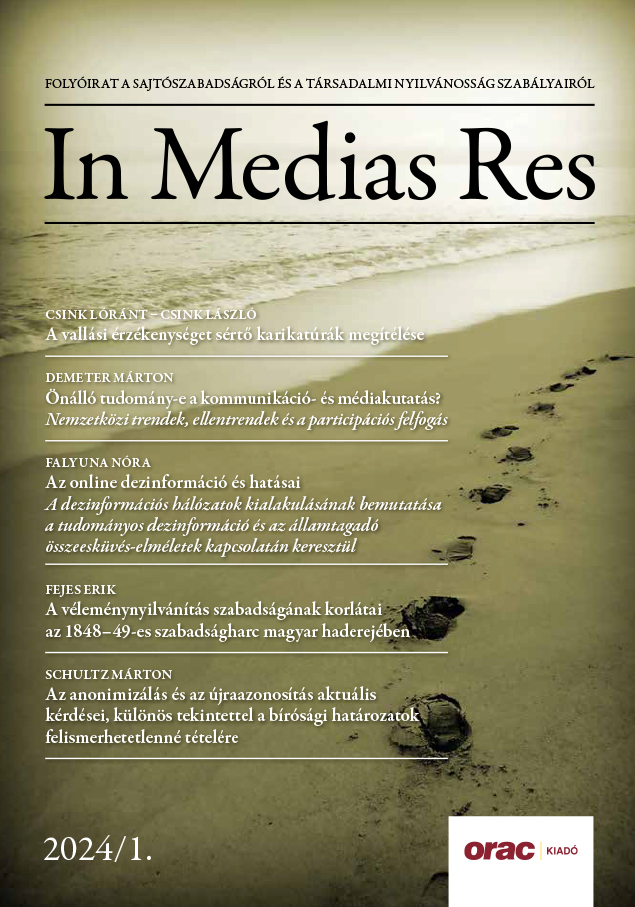Is Communication and Media Studies an Independent Discipline?
International Trends, Countertrends and the Participation Theory of Communication
DOI:
https://doi.org/10.59851/imr.13.1.2Keywords:
participation, network science, health communication, big data, digital journalismAbstract
The disciplinary position of communication and media studies is still uncertain. In scholarly literature, it is usual to see this field of research as a diverse entity without a unified identity. According to many, there is no need to develop such an identity. This study examines whether the participatory theory of communication can discuss communication research traditions that are very different from each other in a unified framework. To test this, the paper analyzes and interprets the conceptual frameworks of health communication, digital journalism, network science, and big data within the system of the participation theory.
References
Ang, Peng H. et al.: Intellectual Balkanization or Globalization: The Future of Communication Research Publishing. 96(4) Journalism & Mass Communication Quarterly (2019) 963–979., https://doi.org/10.1177/1077699019878461
Atkin, Charles – Silk, Kami: Health Communication. In Stacks, Don W. – Salwen, Michael B. (szerk.): An Integrated Approach to Communication Theory and Research. Communication Theory and Methodology. London, Routledge, 2009 (2. kiadás), 489–503.
Caitlin: A Quantitative Turn in Journalism? Chartbeat, 2013. október 31., https://bit.ly/4duufck.
Couldry, Nick – Powell, Alison: Big Data from the Bottom Up. 1(2) Big Data & Society (2014), https://doi.org/10.1177/2053951714539277
Demeter, Márton: On Analysis and Its Role in Communication Theories. 1(1) KOME – An International Journal of Pure Communication Inquiry (2012) 31–45., https://doi.org/10.17646/KOME.2012.14
Demeter, Márton: Changing Center and Stagnant Periphery in Communication and Media Studies. 12 International Journal of Communication (2018) 2893–2921.
Demeter, Márton: Power Relations in Global Knowledge Production: A Cultural/Critical Approach. 15(1) Journal of Multicultural Discourses (2019) 1–17., https://doi.org/10.1080/17447143.2019.1657124
Entradas, Marta: In Science We Trust: The Effects of Information Sources on COVID-19 Risk Perceptions. 37(14) Health Communication (2022) 1715–1723. https://doi.org/10.1080/10410236.2021.1914915
Freelon, Deen: Co-Citation Map of 9 Comm Journals, 2003–2013, https://bit.ly/4a9kZYi.
Gulyás, Adrienn: Traduire Rabelais. 25(1) Hungarian Studies: A Journal of the International Association for Hungarian Studies and Balassi Institute (2011) 37–44., https://doi.org/10.1556/HStud.25.2011.1.3
Gulyás, Adrienn: How Do New Languages Arise? A Comparison of Romanization and Gallicization. Acta Antiqua Academiae Scientiarum Hungaricae, 2019/1–4., 9–18., https://doi.org/10.1556/068.2019.59.1-4.3
Gulyás Adrienn: PETRA-E deszkriptorok a műfordításoktatásban. In Csikai Zsuzsa (szerk.): Iránytű az egyetemi fordítóképzéshez. A műfordítás-oktatás kérdései. Pécs, Kontraszt Plusz, 2021, 39–49.
Horányi Özséb: A kommunikáció mint participáció. Budapest, Typotex, 2006.
Lash, Scott: Power after Hegemony: Cultural studies in Mutation. 24(3) Theory, Culture & Society (2007) 55–78., https://doi.org/10.1177/0263276407075956
David Beer: Power Through the Algorithm? Participatory Web Cultures and the Technological Unconscious. 11(6) New Media & Society (2009) 985–1002., https://doi.org/10.1177/1461444809336551
Lee, Jiyoung – Kim, Yungwook – Kelsey, John P.: Beyond Wishful Thinking During the COVID-19 Pandemic: How Hope Reduces the Effects of Death Arousal on Hostility Toward Outgroups among Conservative and Liberal Media Users for COVID-19 Information. 37(14) Health Communication (2022) 1832–1841., https://doi.org/10.1080/10410236.2021.1921906
Molina, José L. et al.: The Embeddedness of Social Capital in Personal Networks. 8(2) Network Science (2020) 189–203., https://doi.org/10.1017/nws.2019.30
Thurman, Neil: Computational Journalism. In Wahl-Jorgensen, Karin – Hanitzsch, Thomas (szerk.): The Handbook of Journalism Studies. New York, Routledge, 2019 (2. kiadás), 213–229.
Volker, Beate: Social Capital Across the Life Course: Accumulation, Diminution, or Segregation? 8(3) Network Science (2020) 313–332., https://doi.org/10.1017/nws.2020.26
Waisbord, Silvio: Communication: A Post-Discipline. London, Polity, 2019.
Wiley, Sarah K.: The Grey Area: How Regulations Impact Autonomy in Computational Journalism. 11(6) Digital Journalism (2021) 889–905., https://doi.org/10.1080/21670811.2021.1893199
Zelizer, Barbie: Journalism in the Service of Communication. 61(1) Journal of Communication (2011) 1–21., https://doi.org/10.1111/j.1460-2466.2010.01524.x
Downloads
Published
How to Cite
Issue
Section
License
Copyright (c) 2024 Demeter Márton

This work is licensed under a Creative Commons Attribution 4.0 International License.


